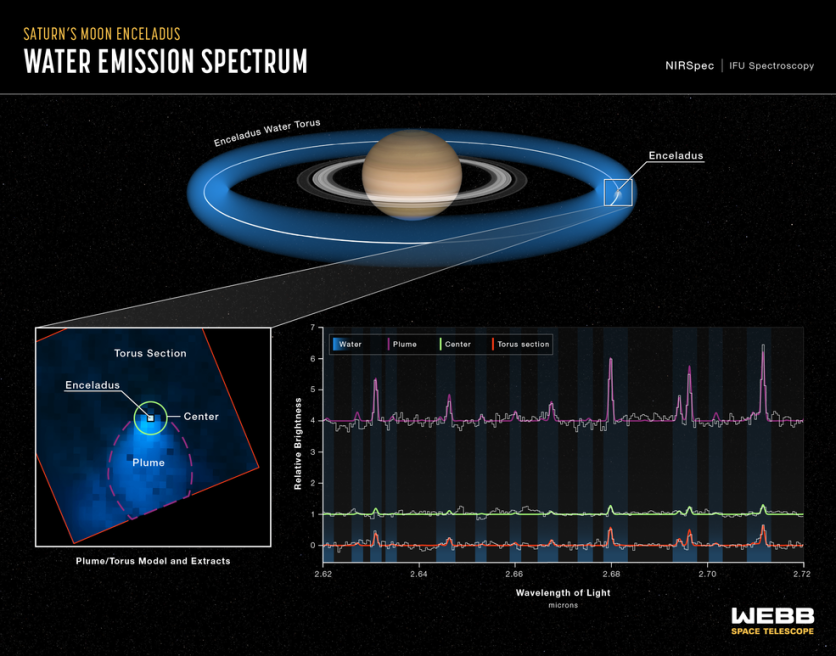NASA's James Webb Space Telescope has made an astounding discovery, spotting an immense water vapor plume originating from Saturn's moon Enceladus.
Stretching over a mind-boggling distance of more than 6,000 miles, the plume spans a range almost equivalent to the sprawling expanse between Los Angeles, California, and Buenos Aires, Argentina.
This observation not only marks the first time such a massive water emission has been observed over such a vast distance but also provides scientists with a unique opportunity to directly observe how this plume nourishes Saturn's entire water system, including its iconic rings.

All About Enceladus
Enceladus, an oceanic world that is only about four percent the size of Earth and a mere 313 miles in diameter, holds tremendous scientific promise in the quest to unravel the mysteries of life beyond our home planet. Situated between the moon's icy outer shell and its rocky core lies a global reservoir of salty water.
Geyser-like volcanoes located on the surface, referred to as 'tiger stripes,' erupt with jets of ice particles, water vapor, and organic chemicals.
While previous observations from other telescopes have mapped the plumes extending hundreds of miles from Enceladus' surface, the James Webb Space Telescope's extraordinary sensitivity has revealed a whole new narrative.
Lead author Geronimo Villanueva of NASA's Goddard Space Flight Center in Greenbelt, Maryland, expressed his initial disbelief upon analyzing the data: "When I was looking at the data, at first, I was thinking I had to be wrong. It was just so shocking to detect a water plume more than 20 times the size of the moon. The water plume extends far beyond its release region at the southern pole."
Researchers are not only fascinated by the extent of the plume but also by the remarkable rate at which water vapor is forcefully ejected, a staggering 79 gallons per second.
This astonishing flow would be sufficient to fill an Olympic-sized swimming pool within a few hours, according to NASA. To put it into perspective, achieving the same result as a typical garden hose on Earth would take more than two weeks.
Fresh Perspective
Cassini Orbiter previously provided insights into Enceladus, but Webb offers a fresh perspective. Webb's observations reveal an enormous plume and widespread water presence on Enceladus as it swiftly orbits Saturn.
Enceladus swiftly orbits Saturn, releasing water as it moves, forming a trailing donut-shaped halo. Webb's observations reveal a massive plume and widespread water presence. The plume overlaps with Saturn's dense "E-ring," creating a fascinating hazy water torus.
The Webb telescope's observations directly illustrate how the water vapor plumes from Enceladus contribute to the formation of the torus. By analyzing the data, astronomers have determined that approximately 30 percent of the water remains within the torus, while the remaining 70 percent escapes to replenish the water supply of Saturn's vast system.
Webb will be the main tool to observe Enceladus, and its discoveries will guide future missions exploring the moon's subsurface ocean, ice crust thickness, and more. The observations of Enceladus were part of Webb's GTO program 1250, showcasing its capabilities and paving the way for future studies.
The findings are available here.

ⓒ 2025 TECHTIMES.com All rights reserved. Do not reproduce without permission.




